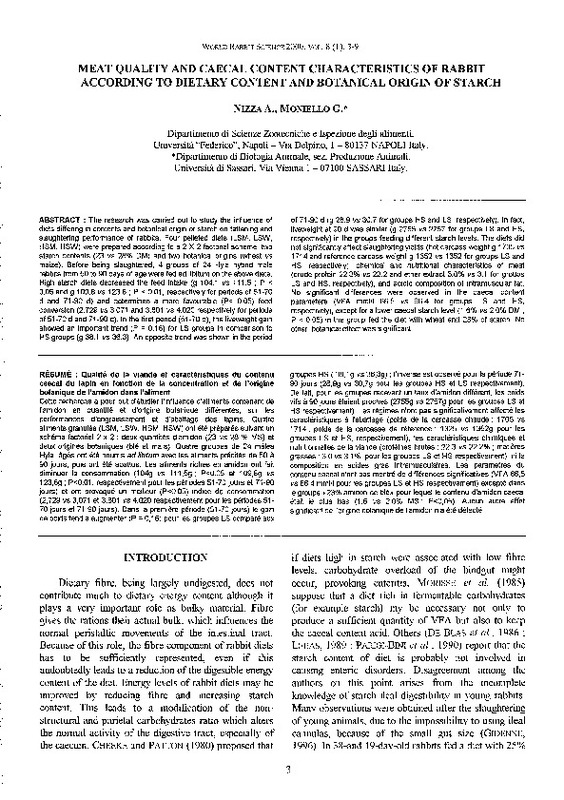JavaScript is disabled for your browser. Some features of this site may not work without it.
Buscar en RiuNet
Listar
Mi cuenta
Estadísticas
Ayuda RiuNet
Admin. UPV
MEAT QUALITY AND CAECAL CONTENT CHARACTERISTICS OF RABBIT ACCORDING TO DIETARY CONTENT AND BOTANICAL ORIGIN OF STARCH
Mostrar el registro sencillo del ítem
Ficheros en el ítem
| dc.contributor.author | Nizza, A.
|
|
| dc.contributor.author | Moniello, G.
|
|
| dc.date.accessioned | 2011-03-11T08:09:22Z | |
| dc.date.available | 2011-03-11T08:09:22Z | |
| dc.date.issued | 2000 | |
| dc.identifier.issn | 1257-5011 | |
| dc.identifier.uri | http://hdl.handle.net/10251/10264 | |
| dc.description.abstract | [EN] The research was carried out to study the influence of diets differing in contents and botanical origin of starch on fattening and slaughtering performance of rabbits. Four pelleted diets (LSM, LSW, HSM, HSW) were prepared according to a 2 X 2 factorial scheme: two starch contents (23 vs 28% DM) and two botanical origins (wheat vs maize). Before being slaughtered, 4 groups of 24 Hyla hybrid male rabbits from 50 to 90 days of age were fed ad libitum on the above diets. High starch diets decreased the feed intake (g 104.1 vs 111.5 ; P < 0.05 and g 109.8 vs 123.6 ; P < 0.01, respectively for periods of 51-70 d and 71-90 d) and determined a more favourable (P< 0.05) feed conversion (2.729 vs 3.071 and 3.801 vs 4.020 respectively for periods of 51-70 d and 71-90 d). In the first period (51-70 d), the liveweight gain showed an importan! trend (P = 0.16) for LS groups in comparison to HS groups (g 38.1 vs 36.3). An opposite trend was shown in the period of 71-90 d (g 28.9 vs 30.7 for groups HS and LS, respectively). In fact, liveweight at 90 d was similar (g 2755 vs 2757 for groups LS and HS, respectively) in the groups feeding different starch levels. The diets did not significantly affect slaughtering yields (hot carcass weight g 1705 vs 1714 and reference carcass weight g 1352 vs 1352 for groups LS and HS, respectively), chemical and nutritional characteristics of meat (crude protein 22.3% vs 22.2 and ether extrae! 3.0% vs 3.1 for groups LS and HS, respectively), and acidic composition of intramuscular fat. No significan! differences were observed in the caecal content parameters (VFA mml/I 66.5 vs 66.4 for groups LS and HS, respectively), except for a lower caecal starch level (1.6% vs 2.0% DM ; P < 0.05) in the group fed the diet with wheat and 23% of starch. No other botanical effect was significan!. | es_ES |
| dc.description.abstract | [FR] Cette recherche a pour but d'étudier l'influence d'aliments contenant de l'amidon en quantité et d'origine botanique différentes, sur les performances d'engraissement et d'abattage des lapins. Quatre aliments granulés (LSM, LSW, HSM, HSW) ont été préparés suivant un schéma factoriel 2 x 2 : deux quantités d'amidon (23 vs 28 % MS) et deux origines botaniques (blé et mars). Quatre groupes de 24 males Hyla agés ont été nourris ad libitum avec les aliments précités de 50 a 90 jours, puis ont été abattus. Les aliments riches en amidon ont fait diminuer la consommation (104g vs 111,5g ; P<0.05 et 109,8g vs 123,6g ; P<0.01, respectivement pour les périodes 51-70 jours et 71-90 jours) et ont provoqué un meilleur (P<0,05) indice de consommation (2.729 vs 3,071 et 3,801 vs 4,020 respectivement pour les périodes 51- 70 jours et 71-90 jours). Dans la premiere période (51-70 jours) le gain de poids tend a augmenter (P = 0, 16) pour les groupes LS comparé aux groupes HS ( 38, 1 g vs 36,3g) ; l'inverse est observé pour la période 71- 90 jours (28,9g vs 30,7g pour les groupes HS et LS respectivement). De fait, pour les groupes recevant un taux d'amidon différent, les poids vifs a 90 jours étaient proches (2755g vs 2757g pour les groupes LS et HS respectivement). Les régimes n'ont pas significativement affecté les caractéristiques a l'abattage (poids de la carcasse chaude : 1705 vs 1714 ; poids de la carcasse de référence : 1325 vs 1352g pour les groupes LS et HS, respectivement), les caractéristiques chimiques et nutritionnelles de la viande (protéines brutes : 22,3 vs 22,2% ; matieres grasses : 3,0 vs 3, 1 % pour les groupes LS et HS respectivement), ni la composition en acides gras intramusculaires. Les parametres du contenu caecal n'ont pas montré de différences significatives (VFA 66,5 vs 66.4 mml/I pour les groupes LS et HS respectivement) excepté dans le groupe «23% amidon de blé» pour lequel le contenu d'amidon caecal était le plus bas (1,6 vs 2,0% MS ; P<0,05). Aucun autre effet significatif de !'origine botanique de l'amidon n'a été détecté. | |
| dc.language | Inglés | es_ES |
| dc.publisher | World Rabbit Science. ICTA. UPV | es_ES |
| dc.relation.ispartof | World Rabbit Science | |
| dc.rights | Reserva de todos los derechos | es_ES |
| dc.title | MEAT QUALITY AND CAECAL CONTENT CHARACTERISTICS OF RABBIT ACCORDING TO DIETARY CONTENT AND BOTANICAL ORIGIN OF STARCH | es_ES |
| dc.type | Artículo | es_ES |
| dc.date.updated | 2011-03-09T09:41:01Z | |
| dc.identifier.doi | 10.4995/wrs.2000.411 | |
| dc.rights.accessRights | Abierto | es_ES |
| dc.description.bibliographicCitation | Nizza, A.; Moniello, G. (2000). MEAT QUALITY AND CAECAL CONTENT CHARACTERISTICS OF RABBIT ACCORDING TO DIETARY CONTENT AND BOTANICAL ORIGIN OF STARCH. World Rabbit Science. 08(1). https://doi.org/10.4995/wrs.2000.411 | es_ES |
| dc.description.accrualMethod | SWORD | es_ES |
| dc.relation.publisherversion | https://doi.org/10.4995/wrs.2000.411 | |
| dc.description.volume | 08 | |
| dc.description.issue | 1 | |
| dc.identifier.eissn | 1989-8886 | es_ES |








